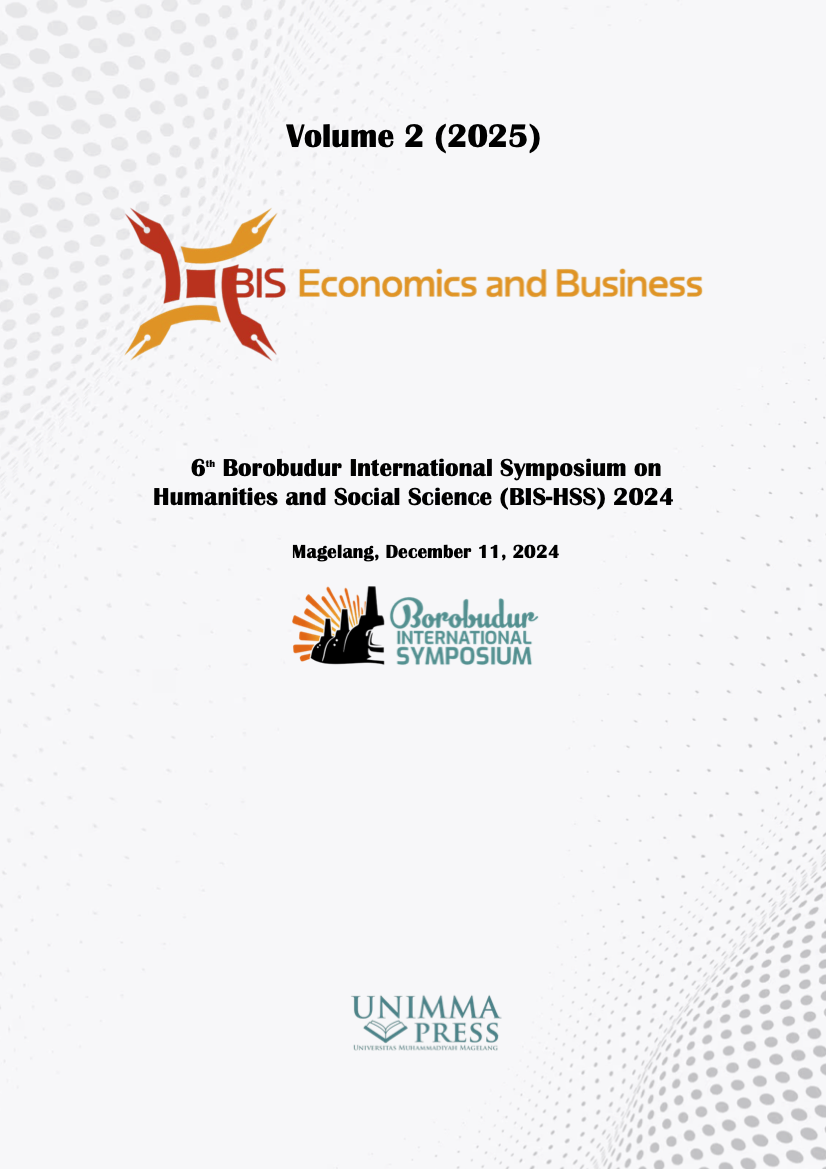Trends in household food expenditure in Indonesia: Analysis of the period 2018–2022
Keywords:
Food expenditure, Households, Economic vulnerability, Food securityAbstract
Food expenditure is an important indicator in analyzing household economic resilience. The high proportion of food expenditure indicates economic vulnerability, especially among low-income households. This study aims to analyze the change in the percentage of households with a share of more than 65% in food expenditure in Indonesia during the period 2018–2022. Secondary data were used from a five-year national survey (2018–2022). The analysis was carried out to identify patterns of change and factors that affect the dynamics of household food expenditure. Results show a decrease in the proportion of households with a share of food expenditure >65% from 40.89% in 2018 to 34.23% in 2022. However, a volatile trend occurred, especially in 2020 and 2021 due to the impact of the COVID-19 pandemic. Certain regions showed significant increases in 2022, reflecting regional disparities. These findings underscore the need for policies to strengthen the household economy and equitable access to food to reduce vulnerability. This analysis can be the basis for policymakers in designing poverty alleviation programs.
References
[1] I. Martadona, “Analisis Ketahanan Pangan Rumah Tangga Petani Padi Berdasarkan Proporsi Pengeluaran Pangan Di Kota Padang,” JURNAL PANGAN, vol. 30, no. 3, 2022, doi: 10.33964/jp.v30i3.544.
[2] E. D. Nurdini and T. Mahmudiono, “Hubungan Status Ketahanan Pangan Rumah Tangga dengan Anemia pada Ibu Hamil (Studi di Desa Bektiharjo Kecamatan Semanding Kabupaten Tuban),” Media Gizi Kesmas, vol. 9, no. 1, 2020, doi: 10.20473/mgk.v9i1.2020.17-22.
[3] D. Parwati, M. Maleha, and T. Y. E. Sintha, “FAKTOR-FAKTOR YANG MEMPENGARUHI AKSES PANGAN RUMAH TANGGA DI KELURAHAN TUMBANG RUNGAN KECAMATAN PAHANDUT KOTA PALANGKA RAYA,” JOURNAL SOCIO ECONOMICS AGRICULTURAL, vol. 16, no. 2, 2022, doi: 10.52850/jsea.v16i2.4015.
[4] H. C. J. Godfray et al., “Food Security: The Challenge of Feeding 9 Billion People,” Science (1979), vol. 327, no. 5967, pp. 812–818, Feb. 2010, doi: 10.1126/science.1185383.
[5] R. D. Wardani and Y. Yuliawati, “PENGARUH KONDISI SOSIAL EKONOMI TERHADAP TINGKAT KETAHANAN PANGAN RUMAH TANGGA DI KOTA SALATIGA PADA MASA PANDEMI COVID-19,” Jurnal Ilmiah Mahasiswa AGROINFO GALUH, vol. 10, no. 1, 2023, doi: 10.25157/jimag.v10i1.8992.
[6] R. Loopstra, “Interventions to address household food insecurity in high-income countries,” in Proceedings of the Nutrition Society, 2018. doi: 10.1017/S002966511800006X.
[7] Ian Christoplos and Adam Pain, “Food security and insecurity in India,” in New Challenges to Food Security, 2021. doi: 10.4324/9780203371176-24.
[8] S. Salamah and B. Kurniawan, “EFEKTIVITAS PELAKSANAAN PROGRAM SEMBAKO SELAMA PANDEMI COVID-19 (STUDI DI DESA KARANGWUNGU LOR KECAMATAN LAREN KABUPATEN LAMONGAN),” Publika, 2022, doi: 10.26740/publika.v10n3.p819-834.
[9] S. Hamdi, Syarifuddin, Oryza Pneumatica Indrasari, and Ega Erlina, “Strategi Pemerintah Membantu Pekerja Migran Dalam Mengatasi Dampak Covid-19 Di Suralaga, Lombok Timur,” Jurnal Kebijakan Pembangunan, vol. 17, no. 2, 2022, doi: 10.47441/jkp.v17i2.289.
[10] Y. Gong, “The impact of China’s financial policy on economic resilience during the pandemic period,” Economic Change and Restructuring, vol. 56, no. 4, pp. 2493–2509, Aug. 2023, doi: 10.1007/s10644-023-09524-6.
[11] Dirjen Tanaman Pangan, “Laporan Tahunan Direktorat Jenderal Tanaman Pangan Tahun 2023,” Kementerian Pertanian Republik Indonesia, Mar. 2024, Accessed: May 11, 2024. [Online]. Available: https://tanamanpangan.pertanian.go.id/assets/front/uploads/document/LAPORAN%20TAHUNAN%202023.pdf
[12] D. D. Headey and W. J. Martin, “The impact of food prices on poverty and food security,” Annu Rev Resour Economics, vol. 8, no. 1, 2016, doi: 10.1146/annurev-resource-100815-095303.
[13] E. Be, “Impact of Rice Production, Rice Supply And Rice Prices on Food Security in North Timor District,” Jurnal Manajemen dan Agribisnis, 2022, doi: 10.17358/jma.19.3.407.
[14] I. G. K. Ansah, C. Gardebroek, and R. Ihle, “Resilience and household food security: a review of concepts, methodological approaches and empirical evidence,” 2019. doi: 10.1007/s12571-019-00968-1.
[15] R. Marsh, “Building on traditional gardening to improve household food security,” Food, nutrition and agriculture, 2018.
[16] J. Cariolle and P. G. Sekeris, “How export shocks corrupt: Theory and evidence,” Journal of Government and Economics, vol. 8, 2022, doi: 10.1016/j.jge.2022.100057.
[17] M. Alnour, H. ALTINTAŞ, and M. N. Rahman, “Unveiling the asymmetric response of global food prices to the energy prices shocks and economic policy uncertainty,” World Development Sustainability, vol. 3, 2023, doi: 10.1016/j.wds.2023.100083.
[18] Ruwan Jayathilaka, Thisum Palihawadana, Inuri Amalka, Sandupama Jayasinghe, and Pulith Jayarathne, “Influence of Socio-economic and Demographics factors on Households’ Savings in Sri Lanka,” Vidyodaya Journal of Management, vol. 8, no. I, 2022, doi: 10.31357/vjm.v8ii.5604.
[19] J. Oh and S. Kim, “Effect of household economic indices on sustainability of community gardens,” Journal of Asian Architecture and Building Engineering, vol. 18, no. 2, 2019, doi: 10.1080/13467581.2019.1623037.
Downloads
Published
Conference Proceedings Volume
Section
License

This work is licensed under a Creative Commons Attribution-NonCommercial 4.0 International License.

